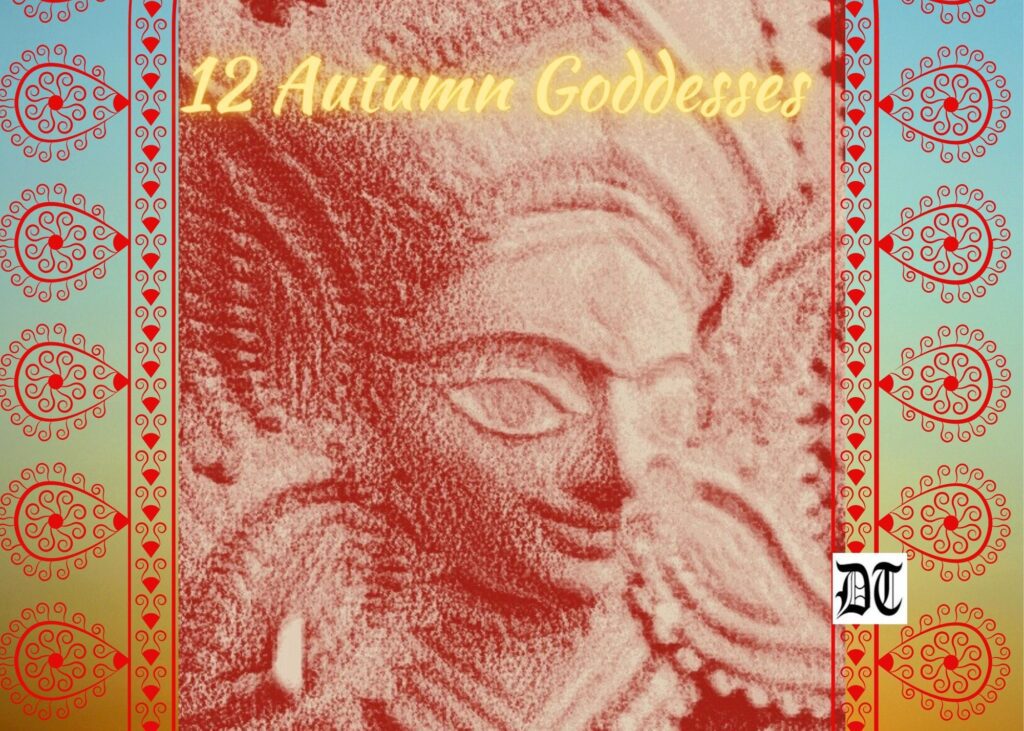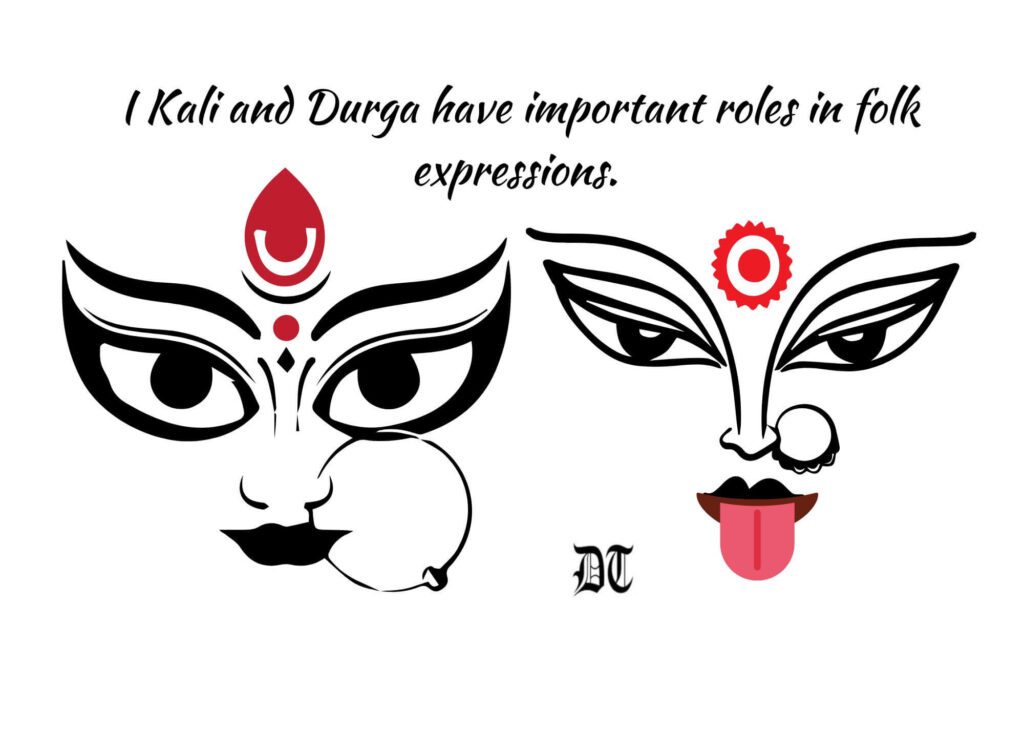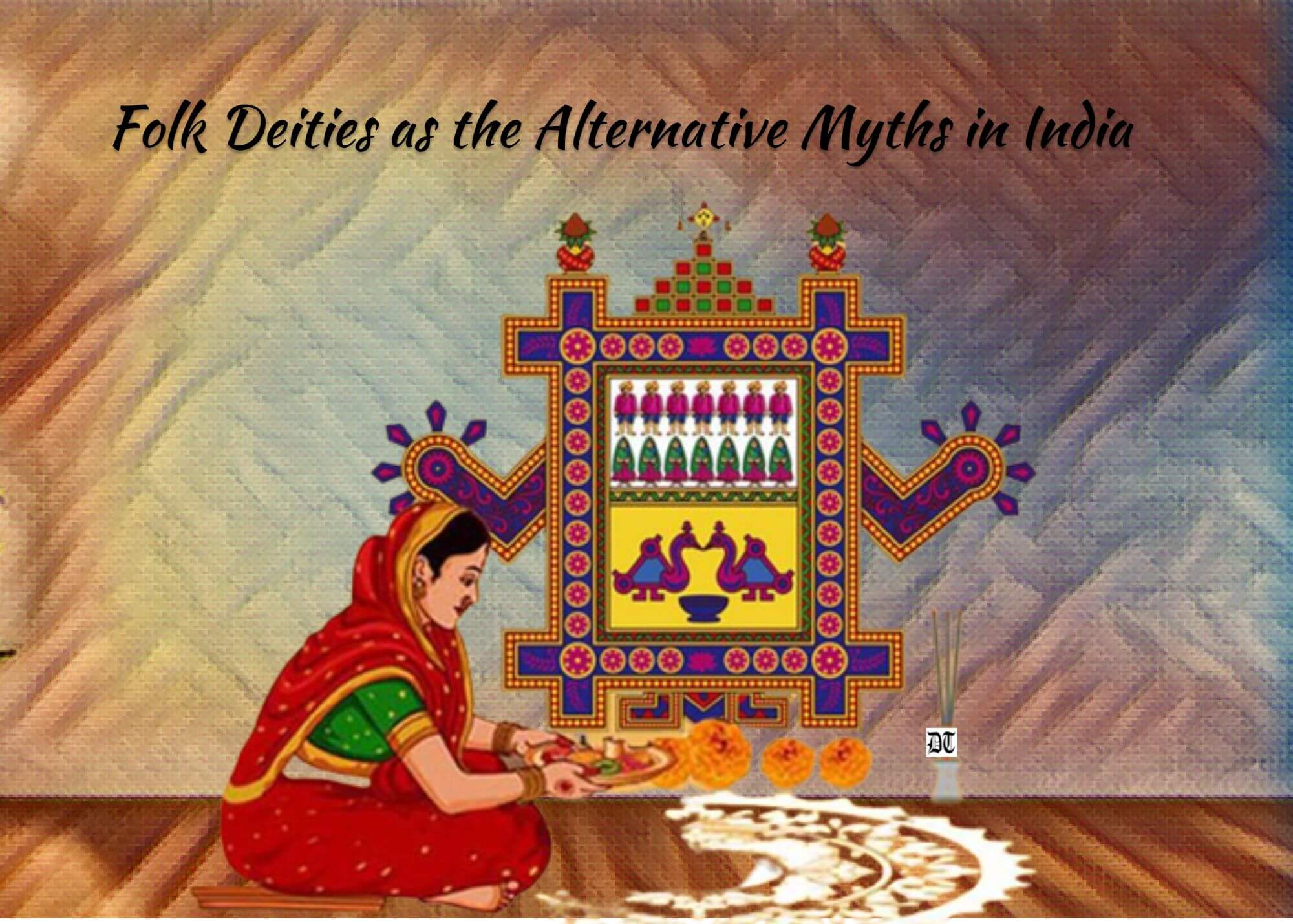Reading Time: 10 minutes
Prof. Nandini discusses myth as an alternative to folk deities; with her exclusive concentration on folk ethnicity, she delves into the partnership between folklore and religion with all its nuances and complexities. Religion is one of the significant substitutes through which we comprehend the surrounding world – an exclusive Special Feature for Different Truths.

In this paper, I aim to interpret and make a critical inquiry of folklore and social epistemology, with special reference to specific folk deities and practices, which I term as ‘alternative myths’ – and I dare do that with a persistent resolve. The Routledge Handbook of Social Epistemology defines social epistemology as “the interdisciplinary inquiry into the myriad ways humans socially acquire, create, construct, transmit, store, represent, revise, and review knowledge, information, belief, and judgment.”
Folklore has been one of the most substantial ways societies direct their characters and transfer their traditional knowledge systems from one generation to progeny. My argument here is not that folklore is stationary, being a reservoir for a lingering past that has no bearing in the present context — that way, I do not romanticise folklore.
My idea of folklore is flexible.
My idea of folklore is flexible. On the divergent side, folklore is intergalactic, where indigenous groups negotiate their knowledge systems with altering and alternative times while they are absorbent of what is crucial to their communal and religious identities. They simultaneously integrate deviations that are obligatory for them, consequently making folklore a dynamic, breathing and existing cultural system. Then, the investigation of folklore can provide useful insights into how social and religious identities of cultures evolve over time and the means through which they are maintained and sustained. This method is particularly germane in the context of the Indian subcontinent, which is rich in multiplicity with various cultures that have a collective dialogic affiliation since time immemorial, being seminal and formative for inimitable socio-religious identities.
With this as my research background, during Durga Puja as the occasion for the benediction of ‘Shakti’, an alternative myth of folk deities, I pose the following research questions in this paper, which I shall consequently attempt to address:
- Comprehend and distinguish ‘folk religions’ and ‘religious folklore’ with their theoretical ethers. Define the devices of critically perusing the connection between folklore and religion, with special reference to folk and local deities. Critically perceive the ways in which religion generates folklore, yet folklore silhouettes religious politics (read, Body Politic). Understand the nuanced traditions in which folklore couriers religious beliefs and subsequently encounters normative behaviour of religion. Focus acumens on collective features and heterogeneity of religious notions articulated through folklore.
Our social identities are instituted on multiple surfaces that embrace gender, caste, class, religion, sexual orientation, physical ability or disability – everything that makes us our elemental selves.
In religions like Hinduism and Buddhism, notions like dharma and dhamma dictate belief systems as a way of life, which would collate one’s attitude towards seemingly secular social realism. It comprises apposite behaviour in all aspects of life, including public, lawful, ethical and cosmological. Our social identities are instituted on multiple surfaces that embrace gender, caste, class, religion, sexual orientation, physical ability or disability – everything that makes us our elemental selves. All these sides impact the ways in which we intermingle with our environs, the way we define ourselves, and epitomise in artistic terminologies of a culture. Folklore of a society absorbs these social structures and characters.
When I talk about myth as an alternative to the folk deities, I penetrate the collaboration between folklore and religion with all their minutiae and convolutions with my singular focus on the folk ethnicities. Religion is one of the momentous substitutions through which we grasp the world around us. Since folklore is an aesthetic countenance of the veracities, cognizant and otherwise of a community, religion establishes a major component of it. F\olklore, as a part of religion, not only replicates the deeply apprehended ethics and theories of a society but also validates the community’s conceptualisation of mysticism and eternal life.
‘Folk Religion’ and ‘Sacred folklore‘, hitherto Hypothetical Debates (subhead)
Hitherto, the set of disagreements and hullaballoos is around the term ‘folk religion’, which I even have the incitement to term as ‘alternative myth’. Before we delve into comprehending the diverse features of folklore and religion, it is imperative to realise what folk religion is and how its discernment has advanced over time. Folklore was primarily considered as inventive terminology of groups measured as pastoral and primitive. Folk religion, subsequently, was seen as a belief system that occurred in conjunction with established and official religions and mythical practices. In the Indian cultural milieu, the classical Sanskritic and Brahmanical performances of religion have mostly taken centre stage in the religious panoptical system at the cost of subversion of important and pertinent local and vernacular practices and theories.
To talk about the intertextuality and polyphony of the folk and the mainstream deities, I would like to take a case study here. The subject of emphasis can be how the northern states in India have a devotion toward Ahoi Maa. She is the folk deity of fertility and fecundity. She shelters and blesses the devotees with good health.
But the dichotomy is that Kali and Durga have important roles in folk expressions.
In many north Indian states, women observe fasts for the welfare of their children. But with the changing roles of society, gendered practices are being challenged. These vicissitudes replicate the dynamic nature of sacred traditions, blurring the thin lines between local/folk deities and the mythical goddesses, like Goddess Durga. However, this goddess Ahoi Maa is not representative of the fragment of Brahminical Hinduism. She does not fit into the cosmos of Kali and Durga. But the dichotomy is that Kali and Durga have important roles in folk expressions. This can be seen as an instance of the alternative mythical practice and evidence that has been espoused and integrated into vernacular philosophies.

Correspondingly, ‘religious folklore’ has been another controversial term, for it implies unofficial practices associated with the mainstream religion. Implying that folk religious practices are ‘unofficial’ or tangential is problematic in folklore research and pedagogy. It is crucial to understand the politics behind the dichotomies like ‘official’ and ‘unofficial’. To begin with, the tendency to speak in binaries is an externally imposed one, and it is specifically Western in nature, derived from the definitions like those given by Durkheim. Also, when we discuss specific religious practices in terms of folk religion or sacred folklore, we imply that these categories are branches or deviations from a centre. This implication is flawed in its perception as it assumes that religion exists somewhere in its pure and essential form. As soon as it interacts with communities, it gets contaminated and hybridised. One needs to challenge such essentialist views of religion when one tends to talk about folklore and alternative myths together.
Folklore on conviction is instituted as an external force, sometimes in routine places that are most commonplace.
Folklore on conviction is instituted as an external force, sometimes in routine places that are most commonplace. As a researcher of folklore and myth, I am wary of considering these two genres as impermeable and watertight compartments. However, I am simultaneously wary of looking at the sweeping ways of intersecting the two without much critical thought by the academia of folklore. Most of these ideas have been fashioned by Western scholars who occupy homogeneous rooms in Cultural Studies. Primaro writes in his article, ‘Vernacular Religion and the Search for Method in Religious Folklife,’ that “by naming and categorising scholars are invested with the power of controlling perceptions about a culture”. (Primaro 37) This curious and exclusionist observation has been somewhat challenged by contemporary folkloristics.
One has to appreciate the rapport between folklore and religion in bi-cultural ways. Religions have a body of folklore that replicates their overriding standards and principles, ethnicities, rites, mythical principles, etc. Thus, folklore is a route to focus on and disseminate religious values. However, folklore can also be utilised to yield religious individualities. Folklore is both a creation of religious homily and a manufacturer of religious theories, particularly when talking about folk deities. Moreover, religious folklore is instituted both within our systematised belief systems and otherwise. As a part of alternative myths, folklore surpasses the much-desired revered space. One can securely contextualise this with the Shakti deifying traditions of the Navaratras, Durga Puja and the devotion towards the folk deities replete in all parts of India. This does not necessarily mean that these two traditions are identical, interchangeable, transposable, and identical.
The exercise or presentation of a folk tradition of Shakti makes it tangible. Simultaneously, it externalises the mythical belief systems.
The exercise or presentation of a folk tradition of Shakti makes it tangible. Simultaneously, it externalises the mythical belief systems. Through repetition and recital, civic society’s inner involvements and profoundly apprehended ideals can be made evident. Religion and religious performs become physical only through praxis when they come in connection with a people. This practice tenderloins and challenges the idea of transparency and the limpidness of religions. By religious views or sacraments voiced through folklore, one can eyewitness the way religious myth resolves with folklore in all genuineness. As a folklorist, it is decisively critical for me to re-think my style of looking at alternative myths, which a candid curiosity has stimulated in reviewing the methods in which the believers articulate their innate religiosity rather than their imminent interests in trying to crush the assorted, multicultural and pluralistic politics into rich classes.
Another example of the folk deity represented as an alternative myth is a tale from Haryana. Folklore, in the forms of folk songs, tales and legends, echoes the composite exchanges between various religious observations. In a folktale from Haryana, a character from the Ramayana is presented as a folk deity. In a folk story, Ravana encounters Bemata –the folk deity who writes the destiny of children — during one of his incognito nocturnal reviews of his subjects. The story exaggerates the node between the classical mythological characters and the folk/local deity. Interestingly, the folktale ends in Ravana’s reception of the powers of Bemata. The existence of these two characters from apparently two disparate dominions is not surprising for the corporeal characters in the folktale. But it is quite a tremor for the mythological characters who are well-thought-out in fitting into the land of classical mythology.
The negotiation between jogis and sufis in terms of syncretism of the amalgamation of different schools of opinions are apt examples of alternative myths.
Also, a concrete example of the plurality of myth and folk beliefs practised amongst multiple groups and the intricacy of the same can be perceived in the interface between jogis and sufis. The negotiation between jogis and sufis in terms of syncretism of the amalgamation of different schools of opinions are apt examples of alternative myths. In the communities, at one point, those divisions were distorted. If we interpret the jogis as Hindus, we waver because they confronted Vedic Hinduism. Also, several jogis are Muslims. Similarly, sufi saints contest established ideas of Islam. In the public domain, phrases like baba, pir, and fakir are used both for jogis and sufis. We need to re-examine and question the idea of ‘alternative myth’, which presumes the existence of ‘pure Islam’, ‘pure Hinduism’, ‘pure folk’ or ‘pure myth’, for that matter. Folktales like Heer-Ranjha echo the fluidity of such religious beliefs. Ranjha, a Muslim, converts into a jogi when he hears of Heer’s marriage to another man. In folk chronicles like these, the hybridity of myth, folklore and their practices are replicated.
Worshipping the Gram Devta / Devi (village deity)is a common practice across the regions in India, and it has a deep connection and connotation with the Adi-Shakti puja. Adulating the ancestors and folk deities like Gugga Pir (the folk snake deity), we replicate local belief systems of cosmology and lifecycle. In north India, the cosmogeny contains Devlok and Naglok— the world of the Gods and the netherworld of the snakes – and I find no better example of an alternative myth than this practice. It also establishes the folk practices of Matlok or Narlok, which is a contingent of the region. Then there is a fourth group that is absorbent of myth and folklore and cuts across the tripartite dissection of Pitrulok (the world of the ancestors).
I am tempted to look at these myths and folk practices from the perspective of Cultural Materialism and Ecocriticism. All these folk belief systems have something to do with livestock and sustainability. In folk authority, it is imperative to mollify the ancestors and keep their spirits happy like the Gods. Their survival wields power over the spirit and perception of the locals as gods/goddesses of the myths they adapt to. Also, snakes have been one of the most relevant menaces to folk societies mainly engaged in agriculture or animal husbandry. Benediction to a snake deity is an image of people’s concerns in their daily lives. Their credence is a discourse of their inimitable worldview and cohabitation with ecology, flora, and fauna.
Orality … is conceded from generation to generation insistently and is rich in connotations, insinuations, orientations, images, representation, and metaphors.
In Indian folkloristics, the oral forms are replete with themes like birth, death, love, marriage and tragedy of human life, the concepts of time, eternity, spirituality, and various rites, rituals, and celebrations different from each other. It replicates the socio-cultural, religious, and pecuniary life forms of the societies, and thus its credentials are a dependable foundation of data. Orality, as is apparent from the terminology, is conceded from generation to generation insistently and is rich in connotations, insinuations, orientations, images, representation, and metaphors. According to Bakhtin, the dialogical process multiplies in discursive space. Several voices demand the textual construction as ‘polyvocal representation’. (Bakhtin 82) The pertinent local deities and folk deities of our concern can be safely interpreted through the lens of multimediality and intertextuality. Multimediality is the distinctive voice of modern media that has the capacity to transport social existence through orality. “We cannot assume that all literature should be written. One doesn’t have to be so patronising about oral literature… The art of the speaking voice can be brought back so easily… We don’t have to write for readers; we can write for the listeners.” (Aidoo 77)
Hitherto, the ethnographer trails monistic illustrations and gives them the authorial supremacy as the ‘informant’ whose voice is narrowed as citation or paraphrase. Once ‘dialogism and polyphony’ are documented as textual creation methods, a text’s monophonic authority becomes disputed. This situation raises critical issues for the oral informers and ethnographers as co-authors. It depicts them as scribe-archivist, correspondingly throwing numerous hermeneutical complications about the process of textualisation and its legitimacy. An ethnographic treatise is neither an object to be epitomised nor an illustration of an object. It moves beyond the figurative meaning of signs. This polyphonous expression can be authenticated by mentioning folk deities from Rajasthan, who are multi-layered in their social statuses and approaches.
The signature folk deities from Rajasthan and many other states are instrumental in constructing an alternative myth with their advocacy for the protection and preservation of ecology. Hingula Devi from Rajasthan and Talcher, Odisha, is the Goddess of Fire. While worshipping her, the devotee is connected to Goddess Hingula from the Hingul River in Afghanistan. Some of these folk deities have been called Pir, consecrated persons. There are important folk deities in Rajasthan, whose names are Pabuji, Harbuji, Ramdevji, Goga Ji, Meha Ji, Elaji, Khetla Ji, Veer Teja Ji, Rani Sati, Rani Bhatiani, Shitala Mata etc. Jambeswar Ji, an important folk deity from the region, advocates for ecological balance, Chipko Movement and the anti-animal killing movements. The fact is that these folk deities are a part of our social mobility and functional myth, thus, a much-needed alternative myth.
The conglomeration of myths and folklore, the amalgamation of local deities with the supposedly ‘canonical’ ones, can be witnessed in almost all public spheres in India.
The conglomeration of myths and folklore, the amalgamation of local deities with the supposedly ‘canonical’ ones, can be witnessed in almost all public spheres in India. To understand the exchanges between myth and folklore, one must understand India’s geographical and cultural heterogeneity and the functional necessity of sacred rituals. This method takes into deliberation the definite sociological, anthropological, and psychological functions that myth and folklore play in a community. It becomes obligatory to penetrate society’s empathetic understanding of the implication of a particular ritual, be it mythical or folkloristic. Dussehra is the occasion for the clear understanding and sensitisation of that belief system, being the apt instance for acceptance and inclusivity of multiple religious practices.
Works Cited:
Eds. Miranda Fricker, Peter J. Graham, David Henderson, Nikolaj J.L.L. Pedersen. Routledge Handbook of Social Epistemology.p.89
Primiano, Leonard Norman. “Vernacular Religion and the Search for Method in Religious Folklife.” Western Folklore, vol. 54, no. 1, 1995, p. 37
Ama Ata Aidoo (https://prezi.com/cdumyaaik5sc/ama-ata-aidoo/)
Mikhail Bakhtin. In Theory Bakhtin: Dialogism, Polyphony and Heteroglossia. (https://ceasefiremagazine.co.uk/in-theory-bakhtin-1/)
Picture design by Anumita Roy, Different Truths

















Very aptly referred as alternative myths!! Wonderful description and insights on mythology and folklore!!